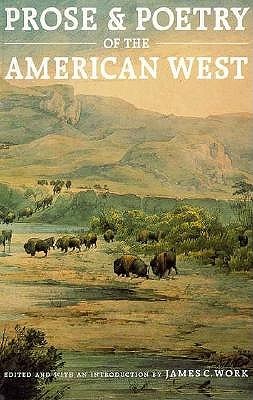“Of making many books there is no end,” Ecclesiastes has it. Like the endless streams of cat-cartoon and celebrity workout books, the flow of books factual or fictional about the American West seems not only interminable but ever-increasing: The region has long been a popular setting for a great mass of pulp fiction, to which hundreds of new titles are added yearly. As writers of higher seriousness abandon the artificial canyons of New York for such sundry locales as southern Arizona and western Montana, not to mention Hollywood and even Texas, a host of books with promise to endure has been joined to what was as recently as two decades ago a very small body of worthwhile writing indeed.
Where there is a literature there is an anthologist, and with the increase of writing from the American West there has been an increase in collections purporting to represent it. In the last few years there have been serviceable gatherings like Russell Martin and Marc Barasch’s Writers of the Purple Sage (Penguin Books), a few dogs like Alex Blackburn’s The Interior Country (Swallow Press), and a slew of inbetweens. James C. Work’s sensibly named Prose & Poetry of the American West makes all but Russell and Barasch’s collection redundant, and is one of the better-conceived anthologies of American writing of any kind.
Given an abundance of high-quality material—and in this instance there is no shortage of good writing on the American West, buried though it may be under a mudslide of dimestore novels—the anthologist’s chief problem is organization. Mr. Work undoubtedly considered many schemes before arriving at the frame of his book, an arguable chronological division of the literature into four major eras.
The editor places the first, “The Emergence Period,” in the years 1540-1832, and he chooses as his exemplars, among other items, a sequence of Native American emergence myths, an account by the conquistador Pedro de Castafieda (a less gifted chronicler than his later compatriots Escalante and Garces), and passages from the always stirring journals of Lewis and Clark. The section closes with Walt Whitman’s lovely ode “Pioneers! O Pioneers!” Here Mr. Work’s division breaks down, for by his own logic Whitman’s well-known poem belongs somewhere near the middle of his next section, “The Mythopoeic Period (1833-89),” which showcases selections from Whitman’s contemporaries Mark Twain, Bret Harte, and John Wesley Powell.
That section also introduces the work of early women writers like the quirky, often brilliant Mary Austin, whose Land of Little Rain and The Land of Journeys’ Ending remain benchmarks of Southwestern writing; Helen Hunt Jackson, whose romantic novel Ramona (1884) introduced New England literary sensibilities to southern California; and Willa Cather, who ranks among the greatest Western writers, period. It is regrettable that Mr. Work could not have found room in his already overstuffed collection for something by Martha Summerhayes, a fine memoirist, but at least he had the foresight to omit an appearance by Mabel Dodge Luhan, who cultivated the arts of decadence and class snobbery in northern New Mexico, where they flourish today.
At heart, mythopoesis simply means the creation of a story, but in Mr. Work’s usage it suggests the formation of a canon. There are a few cracks in the argument—is Luther Standing Bear, for example, to be reckoned as a writer in the same way as John Muir and Stephen Crane? Such questions go unanswered in the interests of cultural inclusiveness, and the editor might have taken a bit more time to explain why it is that one should read (as indeed anyone with an interest in Western writing should) the work of Isabella Bird and Sharlot Hall, the latter being Arizona’s first territorial historian (as well as, although Mr. Work does not address the issue, one of the West’s most vocal and virulent racists).
Mr. Work continues his canonbuilding theme with his third section, “The Neomythic Period (1890-1914),” offering such writers as Wallace Stegner (who properly belongs next to Edward Abbey, figuring here in the closing section, “The Neowestern Period,” as one of the West’s great iconoclasts), the late A.B. Guthrie, Wright Morris, Mari Sandoz, Frank Waters, and John Steinbeck, each of whom contributed to the development of a truly Western literature. In terms of literary quality, this is the best section of the book. Among its many pleasant surprises is the inclusion of Dorothy Johnson’s superb short story “The Man Who Shot Liberty Valance,” a masterwork of compression that is today known mostly through John Ford’s film adaptation.
Mr. Work closes with selections from Ann Zwinger, whose scientific precision and literary skills place her in the forefront of contemporary nature writing; Gary Snyder, the one-time beat poet whose work now stands at the center of American literary environmentalism; N. Scott Momaday and James Welch, who can be jointly credited with the flowering of Native American literature in the last three decades, and Rudolfo Anaya, who holds a similar place in Chicano writing. He also rightly includes work by the Laguna Pueblo poet and novelist Leslie Silko and a harrowing sequence of poems by Jimmy Santiago Baca, whose Albuquerque echoes Dante’s hell. These two writers, like their older contemporaries, extend so-called ethnic literature into the universal.
The occasionally errant organization aside, Prose & Poetry of the American West is a highly useful collection. The editor has taken pains to select works of high quality, as many previous anthologists have not. This critical stance necessarily pushes aside the generic “Western,” the Colt revolver of literature, mass-produced and made of interchangeable parts. Mr. Work’s intelligent headnotes add substantially to the value of the collection, which, despite its high price, will be of interest to a wide audience.
[Prose & Poetry of the American West, Edited by James C. Work (Lincoln: University of Nebraska Press) 733 pp., $25.00]

Leave a Reply